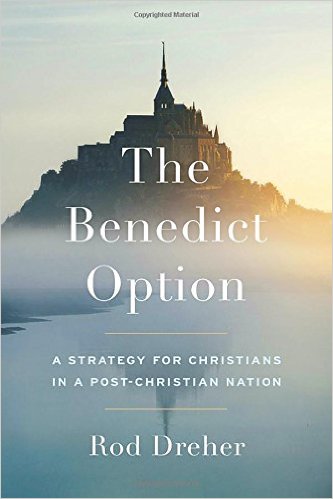The Benedict Option
A Strategy for Christians in a Post-Christian Nation
by Rod Dreher
–Review by Teri Hyrkas
The Benedict Option: A Strategy for Christians in a Post-Christian Nation (Penguin Random House, 2017) by Rod Dreher has become a New York Times best seller, and according to New York Times Op-Ed columnist David Brooks, “is already the most discussed and most important religious book of the decade.” Those are some pretty impressive statements considering that The Benedict Option is about why, in 2017, one might develop a Christian lifestyle drawn from the monastic guidelines of the sixth century Catholic monk, St. Benedict.
What is the Benedict Option? Dreher describes it as a way of life based on the Rule of St. Benedict that is meant to help followers of Christ regain and retain a flourishing Christian culture within the current post-Christian, secular culture. In the introduction Dreher says, “This book does not offer a political agenda. Nor is it a spiritual how-to manual, nor a standard decline-and-fall lament. [It] tells the stories of conservative Christians who are pioneering creative ways to live out the faith joyfully and counterculturally in these darkening days.”
Dreher states that he has been writing articles about the Benedict Option for ten years, but in April 2015 he decided to write the book The Benedict Option to encourage and strengthen the church. Says Dreher, “If we want to survive, we have to return to the roots of our faith, both in thought and in practice. We are going to have to learn habits of the heart forgotten by the believers in the West. We are going to have to change our lives, and our approach to life, in radical ways….”
The life-style suggestions that Dreher makes in The Benedict Option have elicited strong and varied reactions from readers. For this reason, it might be worthwhile to make The Benedict Option a book club selection, or if you are not in a book club, then perhaps you might investigate it with one or two other people. The Benedict Option deserves, and needs, close reading and lively discussion to make the most of its contents.
The Benedict Option has three parts. In the opening section, Dreher presents a brief overview of Western cultural history from the High Middle Ages to the present. At the close of his historical overview, Dreher writes this summation: “The long journey from a medieval world wracked with suffering but pregnant with meaning has delivered us to a place of once unimaginable comfort but emptied of significance and connection.” Today’s empty, broken culture could create connection and find meaning by embracing the Benedict Option, says Dreher.
In the second section of his book, Dreher takes the reader along on his visit to an active Benedictine monastery in Italy – one made up of mostly young American monks. Dreher describes the routines that direct the monks’ days as they obey the Rule, and speaks to many of the men about their outlook on life. Dreher also makes clear here, as he does in various places throughout the book, that The Benedict Option is not an effort to convince people to join a religious community or turn back the clock to antiquity.
The third section of The Benedict Option contains seven chapters in which Dreher presents how the Option might inspire a fresh approach to liturgy, politics, Christian community, education of children, occupations, eros, and technology. Of these topics, I found Dreher’s observations in the chapter on liturgy, called, “A Church for All Seasons,” to be illuminating. Liturgy, explains Dreher, helps to build Christian culture. He believes the absence of an identifiable Christian culture in evangelical churches is one reason for their decline. Dreher writes, “… having no distinct Christian culture of their own, [the church has] been co-opted by the secular culture they wish to evangelize. Without a substantial Christian culture, it’s no wonder that our children are forgetting what it means to be a Christian, and no surprise that we are not bringing in new converts.”
In the chapter called “The Idea of a Christian Village,” Dreher encourages Christians to develop a deep connection to a community of fellow congregants, and notes the deepening of this connection may involve moving closer to one’s church. Dreher tells this story of a couple from an Orthodox Christian church, Shelley and Jerry Finkler: “The Finklers initially thought that living [close to] their church family was weird. Circumstances caused them to live temporarily in the church neighborhood, and they discovered what a difference it made in their family life….” Eventually this couple found a permanent home close to their church in order to take advantage of the vibrant congregational life there.
The Benedict Option: A Strategy for Christians in a Post-Christian Nation by Rod Dreher has piqued a lot of interest, and launched a lot of commentary. The book is seen by many as controversial. My take is that The Benedict Option is an amplified version of John 17: 13-19, which is part of the prayer that Jesus prayed to his Father about how the original disciples would live out the faith in their first century culture: “I’m saying these things in the world’s hearing so my people can experience my joy completed in them. I gave them your word; The godless world hated them because of it, because they didn’t join the world’s ways, Just as I didn’t join the world’s ways. I’m not asking that you take them out of the world. But that you guard them from the Evil One.” (MSG)
The Benedict Option is a daring and provocative book that points to the distant past for a model to strengthen today’s church. Dreher believes St. Benedict’s ancient guidelines are what the church needs to survive the challenges of the present day and to flourish in the future. Why don’t you read The Benedict Option and see if you agree.
https://thewalrus.ca/the-rising-tide-of-educated-aliteracy/#.WNPNUhL4-7V.facebook

